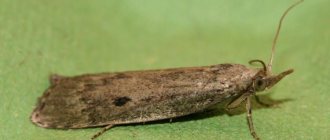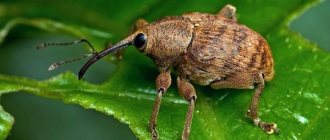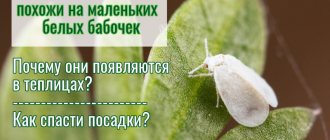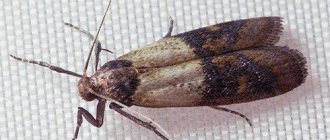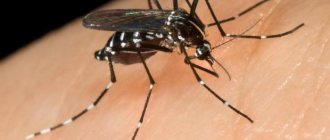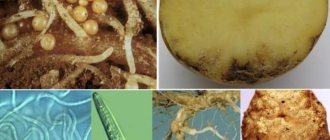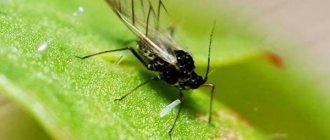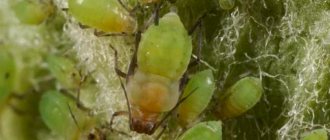It takes a lot of effort to harvest a bountiful raspberry harvest. In addition to thinning and fertilizing plants, it is necessary to combat various pests and diseases. One of the dangerous enemies of culture is the gall midge. Small winged insects lay eggs under the raspberry bark, and their larvae feed on the sap and tissues of the plant. Pests quickly spread through the bushes, so it is important not to miss the first signs of damage.
What is a gall midge?
The gall midge is an unremarkable small insect. Outwardly it resembles a mosquito with a body length from 2 to 5 mm. The insect has a small head, long antennae and black legs, and a brown back. A thin body covered with small hairs and transparent wings make the pest almost invisible. Therefore, gardeners notice the presence of insects on raspberry bushes based on traces of vital activity.
There are about 6,000 different species of gall midges in nature. Raspberries are affected by 2 of them: stem and shoot. They are identical in appearance and the degree of damage caused to the plant.
How to detect on raspberries?
A characteristic sign of raspberry infestation by this pest is growths on the branches that look like swellings:
- The shoot gall midge forms ring-shaped growths. The inner layer of the raspberry stem turns into dust, and cracks form on the bark. Traces of the presence of shoot gall midges can be found in the lower part of the branches, closer to the root.
- Stem gall midge attacks exclusively young shoots. The swellings look like lateral growths, similar to bumps. Their color is brown, the surface is rough.
Important! There may be one or more swellings on the shoot or stem.
What do growths and thickenings on the trunk indicate?
Growths and swellings on the shoots indicate that the female gall midge laid eggs with small legless larvae in cracks in the bark. The pests feed on raspberry juice and the gall gradually grows.
One growth can contain up to 10-11 larvae. They actively suck out the sap of the plant and weaken it. The size of one gall reaches 30 mm. Gradually, the larvae emerge from the growth and pupate in the soil, next to the roots. In the spring, adults emerge from the cocoons and the cycle repeats.
Symptoms
Infection can occur during the vegetative and reproductive stages.
The injury is usually most severe on the outfield.
Gall midges inject specific compounds into the plant that cause the cells to multiply, changing the normal growth habit. In other words, the insect encourages the plant to produce gall as a result of its feeding.
Damage includes interrupted flowering and blackened young stems or tips of young shoots, as well as distorted leaf development.
Symptoms of gall midge damage include:
- gall midges form a silvery-white hollow tube 1 cm wide and 10-30 cm long;
- the affected shoot prevents leaf growth;
- the leaf is deformed, withered and curled.
Curled leaves may also be associated with a symptom caused by thrips. To confirm the cause of the problem, check for insects. In particular, elongated tubular eggs and caterpillar-like larvae feed inside the developing buds.
Damage to gall midges
The pest larvae eat away the shoot tissue from the inside, depriving the plant of its vitality. Branches break even from a slight blow of wind. This means that a bush that survives until winter will not tolerate frost and will die by spring.
Attention! The shoot gall midge causes particular harm to raspberries. The larvae of which, after overwintering in the soil, spread over vast areas and destroy plants.
The tissues of the shoots damaged by the larvae are an open place for the penetration of fungal spores. Raspberries are affected by:
- anthracnose;
- gray rot;
- didimella;
- rust.
Raspberry pests
Wormy berries and dried shoots do not cause delight among gardeners. Hard work in pursuit of a generous harvest can be reduced to zero by a small mosquito or midge. To prevent this from happening, you need to know how insects can damage raspberry plantations. Raspberry pests and methods of controlling them are diverse; they must be recognized and applied correctly.
Raspberry shoot gall midge or raspberry mosquito
A small insect of brownish color with transparent wings and 2 mm long. Produces three generations in one season.
When raspberries bloom, the gall midge leaves eggs at the bottom and middle part of the young stems. Orange-colored caterpillars develop inside the stems, forming swellings on the stems - galls. Affected branches develop poorly and die over time.
In May, adult insects emerge from the galls and begin laying eggs. Within a month, a swelling forms on the stem, above which the branch dries out.
Raspberry stem fly (gall midge)
A small gray fly, 5 mm long, appears in May and does not harm the plantings. The damage is caused by the larvae, which it lays near the leaves and on the tops of the branches. Caterpillars are capable of destroying all the growth of raspberry stems by making ornate passages inside them, causing them to dry out.
When the raspberries bloom, the larvae descend into the soil and overwinter there. In the spring, butterflies come out of the ground and lay eggs at the top of the branches.
Raspberry moth
It lays eggs in the stems, larvae grow in them and swellings called galls form on the stems. Damaged stems break easily and dry out over time. The size of the swelling on the stem reaches 10 cm. The swelling in the presence of stem gall midges is 3 cm.
Raspberry shoot and leaf aphids
The insect is green or black, covered with a shiny coating. Settles in colonies at the ends of young stems and leaves in mid-spring. They feed on plant sap, slowing down its growth. Leaves and branches curl, bend and often dry out. Often carries viral infections.
The eggs overwinter on annual stems near the buds. The awakening of the pest begins simultaneously with the blossoming of the bud. Aphids multiply especially strongly during dry periods.
Raspberry-strawberry weevil or flower beetle
A dark gray beetle with a proboscis 3 mm long overwinters in the ground, under fallen leaves. Lays eggs in buds, gnawing on the stalks. A sign of the appearance of a weevil is wilted buds that hang on the stalks.
The larva, a white caterpillar with a dark yellow head, eats the flower inside. By mid-summer, the larvae turn into adult beetles that gnaw on raspberry leaves.
Raspberry beetle
The insect is gray or rusty in color with reddish edges, 4 mm long, overwinters in the ground, appears on raspberries in May.
It eats weed flowers, then moves to raspberry buds. Eats buds from the inside, ovaries and leaves. Lays eggs on leaves and flowers. The yellowish cross-striped caterpillar eats the berries, causing worms and reducing yield. In July-August, the caterpillars climb into the ground, and in the fall they turn into an adult insect.
Raspberry glass
An insect with a striped, black and yellow color, transparent wings, resembles a wasp. The wingspan is about 3 cm. It overwinters inside the stem or in the roots of raspberries, in swellings - galls.
Her years begin in June. Lays eggs on the soil at the base of the stems. The larvae bite into the shoots and roots inside, causing them to dry out. Overwintering and pupation occurs inside the stem or root. In June, new butterflies emerge to the surface and begin a new breeding cycle.
Raspberry bud moth
In early spring, moth caterpillars appear and overwinter in damaged stems or under fallen leaves. The larva eats the buds, penetrates the stem and pupates in it in May. At the beginning of raspberry flowering, moths appear.
The adult butterfly is dark brown in color with light and golden spots and lays eggs in flowers. Red larvae with a dark brown head appear and eat buds, stems and berries. In the spring, raspberry stems dry out, in which moth caterpillars overwintered.
Spider mite
The insect is so small that it is very difficult to see. A cobweb is noticeable, which is located on the raspberries, on the leaves, on the underside. The mite feeds on sap, which causes the leaves to become discolored, dry out, and fly off. Often appear after the onset of extreme heat without rain.
Raspberry mite
Raspberries are attacked by mites in the spring. It appears when the leaves bloom and settles on the leaves below. The leaves change color, become pale and curly, and finally dry out. The insect overwinters in the kidneys.
Causes of raspberry infection
Not a single raspberry plant is immune from gall midge infection, but most often the insect appears under the following conditions:
- Dense bushes. The pest feels most comfortable in the thickets. The lack of air movement and light in the foliage attracts mosquitoes, and they quietly lay eggs.
- Excess nitrogen in the soil. On overfed raspberry shoots, the bark cracks, and insects lay eggs en masse in these holes.
- High humidity. This factor is also attractive to insects.
Attention! One of the main factors in infecting a raspberry tree with a dangerous pest is planting new plants with galls on the shoots. Therefore, it is necessary to carefully study the purchased seedlings.
Prevention
Any measures to combat raspberry gall midge will not be effective without prevention. To prevent the appearance of mosquitoes overwintering in the soil in the spring, deep digging of the soil is recommended. Peat mulching is used as a measure to delay the flight of insects. A layer of at least 15 cm is poured onto the ground. An important factor is the thinning of the shoots.
If the shoots are severely damaged by pests, it is worth cutting them off completely. Next year new growth will appear, which must be looked after taking into account past mistakes. Carry out insecticidal treatment in a timely manner. To repel raspberry mosquitoes, experienced gardeners advise planting onions and garlic near the shoots. Pests do not like the smell of these vegetables. Dill and parsley will also help drive them away.
How to fight without using chemicals?
The first emergence of gall midges occurs at the earliest possible time, when buds begin to form and bloom on raspberries. The insect goes through 3 stages of development.
Therefore, the fight against it must be waged in all directions at once:
- Repels mosquitoes to prevent egg laying.
- Inspect the bushes and remove shoots with signs of developing growths. If there are few gall midge clutches, the shoots are cut out and burned. For large areas of infection, the method of opening the galls helps. An incision is made on the growths and the larvae are cleaned out. Then the wound is covered with garden pitch, clay or oil paint.
Folk remedies help protect raspberry bushes from insects:
- Dandelion infusion. 1.5 kg of leaves are poured into a bucket of warm water and left for 2 hours. The solution is sprayed generously on the bushes before bud break, then repeated after a week.
- Decoction of onion peels. 1.5 kg of raw materials are poured with 10 liters of boiling water, covered and left for 3 days. Before use, dilute 0.5 liters of infusion with a liter of water. The bushes are sprayed 3 times with an interval of 5 days.
- Infusion of onion pulp. For 10 liters of water take 1 kg of chopped onion. Add 50 g of laundry soap shavings so that the solution sticks better to the branches. Spraying begins with bud break, and then every 10 days until fruit formation begins.
- Mustard powder. The bushes are dusted with it after preliminary wetting the leaves. The soil is spilled with a solution consisting of 10 liters of water and 200 g of mustard.
- Infusion of tansy, wormwood. 350 g of chopped dry grass is poured into 1 liter of water. Then the resulting solution is heated for 15 minutes in a water bath. The broth is infused for 12 hours. Then increase the volume to 10 liters and treat the plants 2 times with an interval of 10 days.
Advice! Spraying with folk remedies is best done in the evening, in dry weather. If it rains after treatment, the procedure is repeated.
Other ways to prevent gall midges on raspberries
To protect raspberries from pests, purchased fungicides are used, as well as solutions made by people. In most cases, more than one raspberry patch, as well as neighboring ones, fall under the invasion of gall midges, since the raids are carried out by a whole swarm of insects.
Experienced gardeners recommend the following measures that can prevent crop loss:
When a summer cottage with raspberries is located near other plantings of these berry plants, the group work of gardeners brings effective results. Coordinated action to combat gall midges prevents the seasonal invasion of mosquitoes, keeping the crop in good condition.
Source
Control with pesticides
Chemicals to combat gall midges are used before flowering begins. Otherwise, harmful substances accumulate in plant tissues and subsequently move into the berries.
According to gardeners, the following insecticides are most effective:
- Arrivo is a contact-intestinal poison with a wide spectrum of action. Plants are sprayed with a solution of 15 ml per 10 liters of water.
- Spark – destroys adult insects and larvae. Dissolve 1 tablet of the drug in 1 liter of hot (40 degrees) water, then increase the volume to 8 liters.
- Calypso is a fast-acting drug that paralyzes the pest’s nervous system. 1 ml of poison is dissolved in 5 liters of water. Treat the plant 2 times with an interval of two weeks.
- Confidor is a systemic drug that penetrates plant tissue and lasts for at least 21 days. Spray with a solution of 1 ml per 10 liters of water.
- Karate - the result of treatment with this drug is visible after 30 minutes. 1 ampoule of the product is dissolved in 1 liter of water.
Carefully! When working with chemicals, it is necessary to protect your skin and eyes. While processing bushes, you should not drink, eat or smoke.
What can you do to avoid losing your harvest?
- When pruning a bush, I always recommend leaving one or two young replacement shoots as a reserve, depending on the size of the bush and its age. As a rule, one, rarely two, shoots are affected by gall midge in a bush.
- Grow varieties that are resistant to all diseases and pests.
- Use mosquito repellents from raspberries - infusions of tobacco, mullein, walnut leaves, bird cherry, nettle, wormwood, etc. Spray in the evening, since mosquitoes begin their actions at nightfall and throughout the night.
- The gall midge does not like onions or garlic - you can even plant perennial onions - batun, chives and others - between the rows of raspberries.
- A good effect is obtained from the organized, simultaneous, timely work of all gardeners to combat gall midges.
Watch the video to see what raspberry stems look like when infected with stem gall midge. I just want to warn you that the authors of the video advise treating raspberries with drugs against leaf-eating pests. Apparently, they have not yet figured out what kind of pest they are dealing with. This method will not work against gall midges.
The experience of fighting gall midges of one of our readers was very encouraging - his comment below.
Preventive measures
It is easier to prevent a pest infestation than to get rid of it later. To do this, you should adhere to the following recommendations:
- Selection of healthy planting material. Seedlings with signs of gall are discarded and burned.
- Compliance with plant watering standards.
- Shallow autumn digging of the soil around the bush to destroy pest pupae.
- Planting plants with a pungent odor that repels insects near the raspberry tree: lavender, onions, garlic, dill, parsley. However, this method works in conjunction with other measures.
- Timely thinning pruning of bushes to prevent thickening.
- Mulching the soil with pine sawdust or pine needles.
- Trimming lower stems. Removing shoots in this part of the bush does not reduce the raspberry harvest, since fruit buds do not form there. This technique reduces the possibility of gall midges laying eggs.
Important! There are raspberry varieties that are immune to gall midge infection: Credo, Phenomenon, Vera. Planting a remontant variety, the shoots of which are completely pruned in the fall, also serves as a kind of protection against the pest.
Comprehensive measures for the prevention and destruction of the pest will help protect the raspberry tree and preserve the harvest. Compliance with the rules of caring for raspberries is one of the main conditions for the fight against the dangerous insect gall midge.
5/5 — (1 vote)
Ways to fight
How to deal with gall midge? Measures to combat it include the use of various chemicals, insecticides, as well as some agricultural practices.
First, let's talk about agricultural practices. Let us highlight the main techniques that are considered the most effective:
- It is necessary to carry out sanitary cleaning in spring and autumn. This cleaning involves pruning shoots that have already produced a harvest and eliminating diseased and weak branches. All trimmings must be burned or taken to places away from garden plots.
- Loosening the soil to a depth of ten centimeters. This helps fight gall midges and larvae. The method is not very effective, but it is worth using at least to detect the presence of pests. If you loosen to a depth of fifteen centimeters, you can increase the efficiency and effectiveness of the measure. However, a difficulty arises here - there is a risk of damage to the root system.
- The soil near the roots must be mulched. Peat is used for this. Peat layer 10 centimeters. Mulch will help delay the emergence of mosquitoes.
